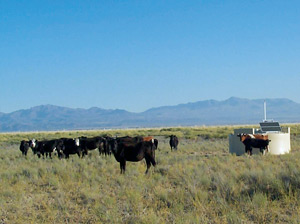 |
|
Photo courtesy of Pierre Auger Collaboration |
Weird new hazard: snoopy, itchy cows
In the control room in Argentina, the detector screen went blank.
“We've been cowed again,” announced an exasperated scientist.
When the Pierre Auger collaboration installed 1600 particle detectors across a large swath of desert near Malargüe, Argentina, it planned for the climate: sand, salt, freezing rain.
But it didn't consider livestock.
“Cows have two properties: They are very curious and won't leave anything alone, and they like to scratch themselves,” says Paul Mantsch, the project manager, and, fortunately, a farm boy. “If they find a sharp edge, they go crazy scratching.”
Each detector consists of a water tank, solar panels, and a battery storage box. By capturing particles produced when cosmic rays hit the atmosphere, scientists hope to discover where the highest-energy rays come from and whether all galaxies have black holes at their centers.
Only a handful of detectors had been produced and installed when the problems began. To a cow that couldn't find a tree for miles, the battery storage boxes looked very inviting. “They kept scratching themselves on them and pushing the boxes around until they disconnected,” Mantsch says.
The team immediately switched designs: From that point on, the boxes had rounded corners. “We haven't been cowed since,” he says. “It's been almost five years now.”
The installation was completed in June. A second set of detectors being built for an array in Colorado will also be cow-proof.
The team shrugs off the cow conundrum as just part of doing science. “We confront all kinds of hazards doing science, but that is the exciting part,” Mantsch says. “When you see your results on the cover of Science [in fall 2007], it's worth it.”
Tona Kunz
Click here to download the pdf version of this article.






